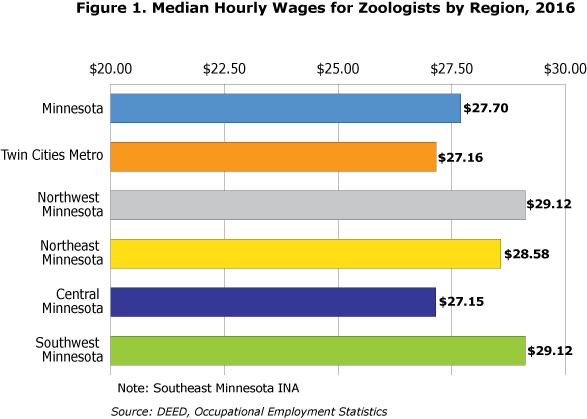by Cameron Macht
March 2017
Known as the land of 10,000 lakes — actually 11,842 lakes of 10 or more acres — the state of Minnesota also has over 6,550 natural rivers and streams, about 10.6 million acres of wetlands, 17.4 million acres of forest land, and 1.1 million acres of state-run wildlife management areas all teeming with fish, birds, and animals. According to the Minnesota Department of Natural Resources, Minnesota is home to 428 bird species, 78 mammal species, 53 reptile and amphibian species, and 1,600 native flowering plants.1
That makes Minnesota fertile ground for zoologists and wildlife biologists, who “study the origins, behavior, diseases, genetics, and life processes of animals and wildlife.” They “may specialize in wildlife research and management, [and] may collect and analyze biological data to determine the environmental effects of present and potential use of land and water habitats.”2
Data from DEED’s Occupational Employment Statistics (OES) program show there were 680 zoologists employed in Minnesota, with over 80 percent of them working in the public sector. Median wages for zoologists were just under $28 per hour and just over $57,500 per year in Minnesota in 2016. Interestingly, median wages were actually higher in Greater Minnesota than in the Twin Cities metro area (see Figure 1).

Zoologist jobs require a bachelor’s degree, although some may also have advanced degrees. There are seven training programs for zoologists and wildlife biologists in Minnesota, although they have relatively small numbers of graduates. The largest programs are at the University of Minnesota and St. Cloud State University, which both had more than 20 completers (see Table 1).
| Table 1. Minnesota Training Programs for Zoologists and Wildlife Biologists | |||
|---|---|---|---|
| School Name | Location | Program Name | Length/Graduates |
| Bemidji State University | Bemidji | Wildlife, Fish, and Wildlands Science and Management | 4 years/1 |
| Carleton College | Northfield | Animal Behavior and Ethology | 4 years/1 |
| St. Cloud State University | St. Cloud | Ecology | 4 years/20 |
| University of Minnesota | Minneapolis | Wildlife, Fish, and Wildlands Science and Management | More than 4 years/0 |
| University of Minnesota | Minneapolis | Ecology | 4 years/22 |
| University of Minnesota | Minneapolis | Entomology | More than 4 years/10 |
| Vermilion Community College | Ely | Wildlife, Fish, and Wildlands Science and Management | 2 years/11 |
| Source: CareerOneStop Credentials Center | |||
Because the number of graduates is so low, data from DEED's Graduate Employment Outcomes are unavailable on an annual basis for zoology programs. However, data covering the 2006-2009 school years show that there were 32 graduates from Zoology/Animal Biology programs in the state, with median hourly wages of $27.79 in the fifth year after graduation.
Current demand for zoologists is also relatively low, ranking in the bottom category of demand across the state. Occupations are rated using a combination of various labor market data, and then assigned an indicator from 'Five Stars' (more favorable current demand conditions) to 'One Star' (less favorable) – and zoologists are firmly planted in the One Star classification. There were just five openings for zoologists in the most recent Job Vacancy Survey, which is right in line with the average over the past five years.
According to DEED's Employment Projections tool, the state is expected to need about 30 new zoologists over the next decade, a 4 percent growth rate. However, the larger amount of future demand will come from replacement openings, where there are expected to be 190 total hires as current zoologists leave the job or the workforce altogether.
Zoologists and wildlife biologists work both indoors and outdoors and both alone and in teams. Many may spend time in the field studying animals in their natural habitats, inventorying plant and wildlife populations, organizing and conducting experiments, and gathering data. They also spend considerable time in the office interpreting findings, writing reports and scientific papers, and making planning recommendations on management systems and options.
This includes work with the public, who don't always have the same interests in mind, which can lead to conflict and challenging interactions. Eighty-four percent of zoologists reported having to deal with unpleasant or angry people once a month or more, and 58 percent said they encountered conflict situations once a month or more. Over half said they had face-to-face discussions every day, and 50 percent said that working with a team or group was extremely important (see Table 2).
| Table 2. Working Conditions for Zoologists and Wildlife Biologists |
|---|
| Electronic Mail - 100% responded "Every day". |
| Deal With Unpleasant or Angry People - 84% responded " Once a month or more but not every week". |
| Telephone - 69% responded "Every day". |
| In an Enclosed Vehicle or Equipment - 61% responded " Once a week or more but not every day". |
| Frequency of Conflict Situations - 58% responded " Once a month or more but not every week". |
| Time Pressure - 56% responded " Once a month or more but not every week". |
| Coordinate or Lead Others - 56% responded "Very important". |
| Indoors, Environmentally Controlled - 56% responded " Once a week or more but not every day". |
| Face-to-Face Discussions - 56% responded "Every day". |
| Work With Work Group or Team - 50% responded "Extremely important". |
| Source: DEED Career and Education Explorer tool |
1"Minnesota Facts and Figures." Minnesota Department of Natural Resources.